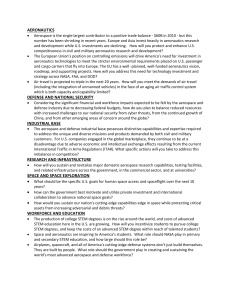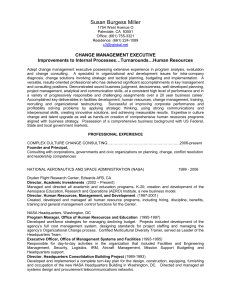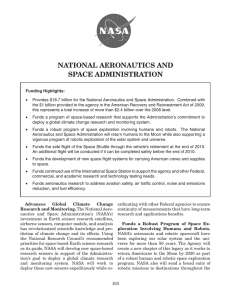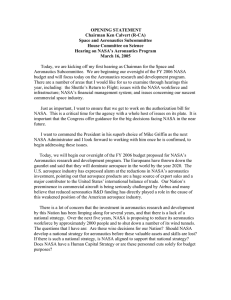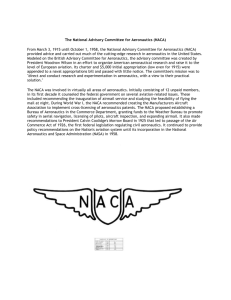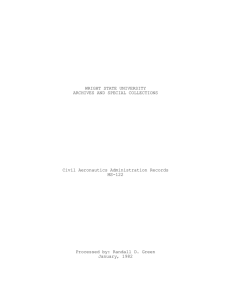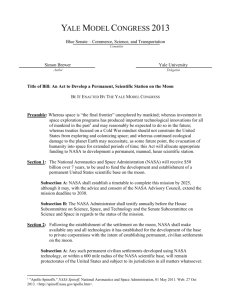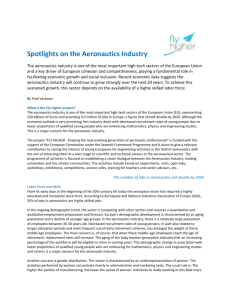Statement of Dr. M. J. Benzakein Chair, Aerospace Engineering The Ohio State University
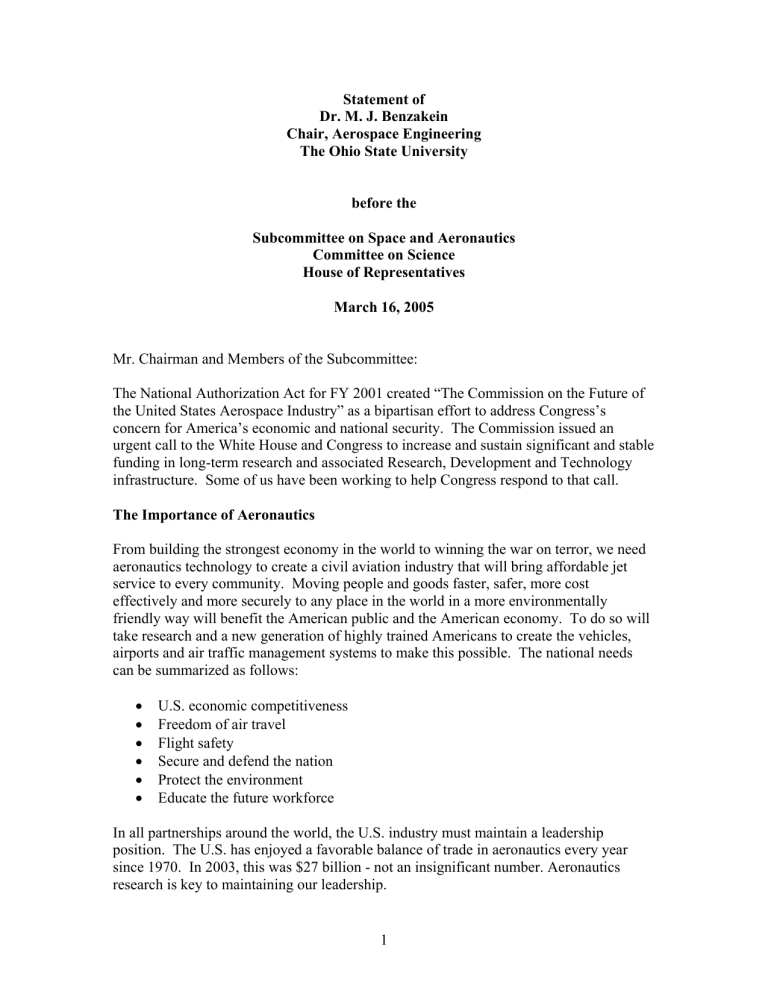
Statement of
Dr. M. J. Benzakein
Chair, Aerospace Engineering
The Ohio State University before the
Subcommittee on Space and Aeronautics
Committee on Science
House of Representatives
March 16, 2005
Mr. Chairman and Members of the Subcommittee:
The National Authorization Act for FY 2001 created “The Commission on the Future of the United States Aerospace Industry” as a bipartisan effort to address Congress’s concern for America’s economic and national security. The Commission issued an urgent call to the White House and Congress to increase and sustain significant and stable funding in long-term research and associated Research, Development and Technology infrastructure. Some of us have been working to help Congress respond to that call.
The Importance of Aeronautics
From building the strongest economy in the world to winning the war on terror, we need aeronautics technology to create a civil aviation industry that will bring affordable jet service to every community. Moving people and goods faster, safer, more cost effectively and more securely to any place in the world in a more environmentally friendly way will benefit the American public and the American economy. To do so will take research and a new generation of highly trained Americans to create the vehicles, airports and air traffic management systems to make this possible. The national needs can be summarized as follows:
•
U.S. economic competitiveness
•
Freedom of air travel
•
Flight safety
•
Secure and defend the nation
•
Protect the environment
•
Educate the future workforce
In all partnerships around the world, the U.S. industry must maintain a leadership position. The U.S. has enjoyed a favorable balance of trade in aeronautics every year since 1970. In 2003, this was $27 billion - not an insignificant number. Aeronautics research is key to maintaining our leadership.
1
Leadership is based on the fact that we own the right technologies, which permit us to adopt the right market and product strategies. This could change in the next 10 years.
The European Union, as well as a number of Asian governments and, most recently, the
Canadian government, are making the necessary investments to threaten our leadership position in this industry. The European 2020 Vision unequivocally states that the E.U. wants to be #1 in aeronautics by the year 2020. They have increased their funding in aeronautics by a factor of 20 over the last 10 years. To this one can add the individual
European governments’ funding (United Kingdom, France, Germany, etc.). Europe is also developing a strong partnership between industry, government and academia. In fact, it is led by industry and focused on their near-term and mid-term needs.
Meanwhile, U.S aeronautics research is focused primarily on more revolutionary, long term research instead of the need to maintain our economic competitiveness. We need a balance between long-term and shorter-term research. In addition as we move forward, aeronautics research must develop the tools and technologies to provide the comfort, performance, fuel economy, and reduced emissions and noise expected by the traveling public. These advanced tools and technologies require research on airframe and propulsion for both large and small vehicle systems.
We need to facilitate the ease of travel from point to point with small vehicles as well as meet the requirement to travel faster around the globe. Technology breakthroughs are critically needed for acoustics and fuel efficiency. We are at the point of diminishing returns with current technologies, and the United States needs to fund R&D for quantum improvements as we move forward.
There is also a necessity to triple the current airspace capacity in the U.S. To accomplish this will take close cooperation between the different agencies of the Federal
Government, industry and academia. The freedom of air transportation and America’s ability to advance economically are lost if the aviation system is not safe, secure and capable of handling the increasing demand for airspace. It is critical that the research agenda recognizes current and future system vulnerabilities based on changing transportation concepts and designs.
Last but not least, we need to educate our workforce. There is an increased demand for students in Aeronautical Engineering. We need to interest young people in science and engineering. We have to start at K through 12, continue through college. We must prepare undergraduate and graduate students - B.S., M.S., and Ph.D. candidates - for what should be very exciting careers in aeronautics. We need more U.S. students pursuing advanced degrees. These young people will be key if the United States is to maintain its aeronautics leadership in the world.
NASA’s Role
So what role should NASA play in the aeronautics agenda? Let me start by saying that technologies developed by NASA have been key to the success of jet engines, which is the industry where I have spent most of my life. The Energy Efficient Engine Program,
2
the Quiet Engine Program, etc., sponsored by NASA in the 1970’s and 1980’s identified technologies that eventually found themselves in product lines like the GE90 family of engines that powers the Boeing 777 today. They have also spawned products like the
GEnx which will power the Boeing 787 tomorrow. Without this research, GE could not have had the composite fan blades, the high pressure-ratio core, or the low emission double annular combustor that put them in a leading position in the industry today.
Why NASA? The answer is simple: There is no other agency that can take that role in the United States today. In 1915 Congress created the National Advisory Committee for
Aeronautics (NACA); this organization was reconstituted as NASA in 1958 as the United
States entered the race for space. From 1915 onward, NACA/NASA has invested in aeronautics research and technology - an investment in the future of this nation. Over the years, Industry and Academia have come to depend on NASA's support to invest in longer term research - but always with an eye to providing a benefit to the American public. This investment has been small compared to the infrastructure it supports and the balance of trade benefits it brings.
DOD, of course, has the technical expertise in airframe and engine systems, but their focus is on weapon systems as it should be, and
DOD does not have the same priorities as civil aviation. In fact, DOD has traditionally relied on NASA to provide noise and emissions breakthroughs that could be adopted by the military. While FAA’s research mission is similar, they have neither the expertise nor infrastructure required.
How effective are NASA’s programs? They have been very effective in the 1970’s and
1980’s as I previously said. Unfortunately, the critical link to industry began to break down in the late 1990’s. The termination of the High Speed Research Program and the
Advanced Subsonic Technology Program marked the beginning of a downslide that continues today. The curtailment of budgets dictated by the funding needs of the
International Space Station and other space projects has left the agency struggling to identify its mission and agenda in aeronautics. It has valiantly tried. The NASA
Aeronautics Blueprint published in 2002 articulated very well the correct goals of the agency. Unfortunately, adequate funding was never there to fulfill these goals. More important, the funding was never stable enough to launch and sustain any significant initiatives. So NASA’s effectiveness in helping to ensure the U.S. industrial competitiveness in civil aeronautics is unfortunately diminishing. The intellectual power is still there, the facilities are still there, and so is the will to do it; but the funding is not.
This is creating a serious void for this nation as we look ahead.
Budget Cuts
That brings me to the next subject – the impact of budget cuts. I am sorry to say that these cuts are having and will have serious implications on the ability of NASA to continue to play a relevant role in aeronautics in the future. The cuts have occurred primarily in the Vehicle Systems Program, which defined technologies for the airframe and propulsion systems of the future. These technologies are aimed at ensuring U.S. competitiveness in the years ahead. The cuts that were made unfortunately affect not only the programs that industry needs, but cut into the core of NASA competency and
3
facilities at centers like Glenn and Langley. These centers have some competencies unique to the nation and the world, and we are going to lose them. In a few years, both people and facilities will be gone with little chance for recovery.
NASA has refocused the Vehicle Systems Program to address four revolutionary high risk “barrier breaking” technologies. They represent a valiant effort to salvage what is remaining of the vehicle system programs. However, the funding constraints make even these programs highly inadequate. Let me take for example the supersonic airplane program which focuses on the need to reduce the sonic boom. We need to do it and it is the right thing to do, but it currently focuses only on changes in airframe configuration.
At the same time there are a flock of technologies dealing with materials, engine emissions and engine noise, airplane systems, etc., that must be addressed if we want to have a supersonic airplane program in the future.
That takes us back to what is NASA’s aeronautics mission? Before I speak to this, let me discuss the role of the industry. When DOD develops technology, it does so for its own use, its own vehicles, its own weapons systems. The technologies that NASA develops for civil aviation will be used primarily by industry and the FAA. It is therefore paramount that a very strong partnership exists between NASA and its stakeholders. This kind of strong partnership exists in Europe where industry shapes most of the technology programs. The U.S. needs to learn from this relationship. The end user has to be part of the process. Is this “corporate welfare?” The answer is no. Industry looks to NASA to screen technologies and help define the key game changers that are worth pursuing.
Let’s take, for example, the NASA Clean Combustor Program. Under this 1970’s
NASA program, GE looked at different combustor concepts to reduce nitric oxides (NO x).
GE identified a double annular configuration as a leading candidate, ran it in an engine and declared victory. But it wasn’t until the mid 1980’s that the pressure for low NO x was such that GE decided to put the double annular combustor into some of their products. It cost GE over $100 million to make it service ready for the CFM and GE90 families. I use this example to show that industry is not looking for NASA to fund the development of their products, but they do need NASA’s help to do the fundamental research and screening of high-risk concepts before industry picks them up. This alliance works. It has gotten the U.S. aeronautics industry its leadership position, and we need to ensure that it stays intact.
The Go Forward Plan
So where do we go from here? I believe that aeronautics needs a national vision and an agenda to move forward. I believe also that the vision and strategy must be developed in partnership by industry, academia and the Federal Government. It should be focused on aeronautics priorities based in future commercial regulatory challenges. Challenging aeronautical goals for 2015/2020 need to be established targeting 85% lower emissions,
50% lower noise, 30% lower fuel consumption, 3 x thruput, etc. Aeronautics must have a vision and specific goals like those that NASA has for returning to the Moon and going to
Mars. So, how do we get this started? Well, we already have.
4
In response to the Aerospace Commission Report and other National studies, Congress asked the National Institute of Aerospace to work with the aeronautics industry and academia to develop an aeronautics research plan and budget for the next five years that would substantially augment ongoing NASA programs. More than 250 of the nation’s aeronautics/aviation experts from industry and academia have developed an integrated budget plan that contains roadmaps, milestones and funding requirements for aeronautics technology to address the nation’s needs in the years ahead. It addresses the requirements for:
• airspace systems
• aviation safety and security
• hypersonics
• rotor craft
• subsonic vehicles
• supersonic vehicles
• workforce and education
The result of this intense effort that has taken place over the last five months is being summarized in a report to Congress that is targeted to be available by the end of this month. The team has worked hard to balance the short and long-range needs of the nation. The short-range needs address technologies for systems and vehicles to be ready in the years 2015-2020. The long-range needs address requirements for systems required in the years 2040-2050. In addition to research requirements, we addressed the need for a strong aerospace workforce, suggesting coalitions to revamp the way we prepare students for careers in industry. The proposal is to transform aeronautical engineering programs to meet industry needs and will require a paradigm shift in emphasis on the way we educate B.S. students, and will require a collaboration of all elements that make up the educational system.
As said earlier, this report should be available to Congress and to NASA by the end of this month. We look to Congress and the Administration to call for a national vision for aeronautics and hope that this report will serve as a baseline upon which to build the aeronautics strategy for the future
Summary
Thank you, Mr. Chairman and Members of the Subcommittee. I appreciate the opportunity to testify today and to share my views on aeronautics and the role that NASA plays in aeronautics research. The partnership between NASA and industry has meant success to the United States in aeronautics in the past. The budget pressures on NASA are at the point of potentially creating a technology void in the future. It is important that this be turned around. The opportunities are there, the needs are there and a strong partnership between industry, academia and NASA with strong, stable support from
Congress and the Administration is the answer.
5
